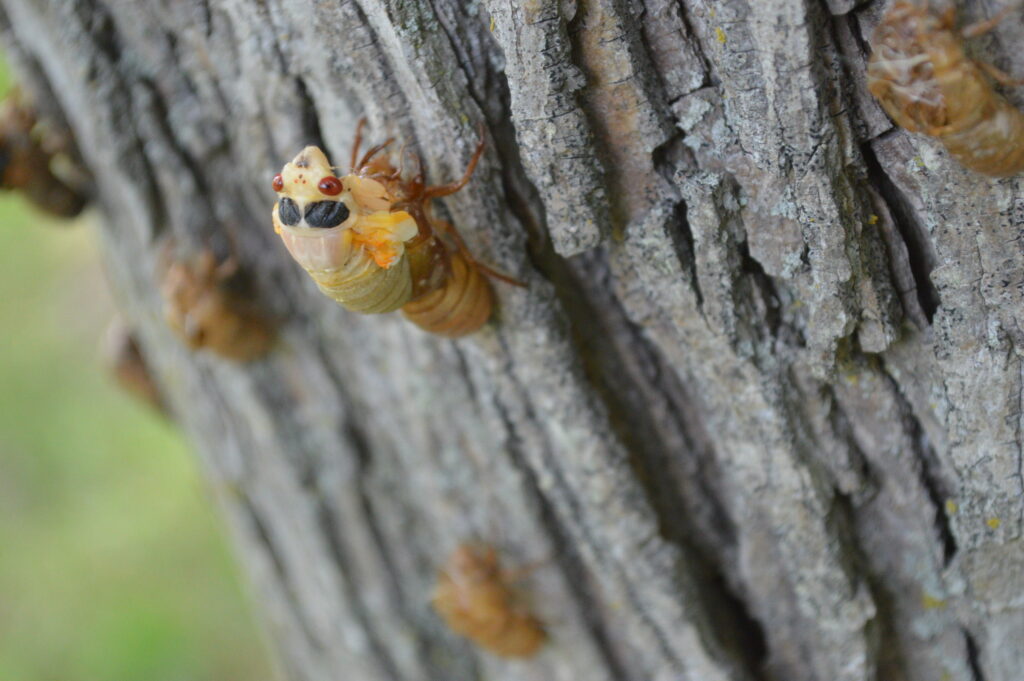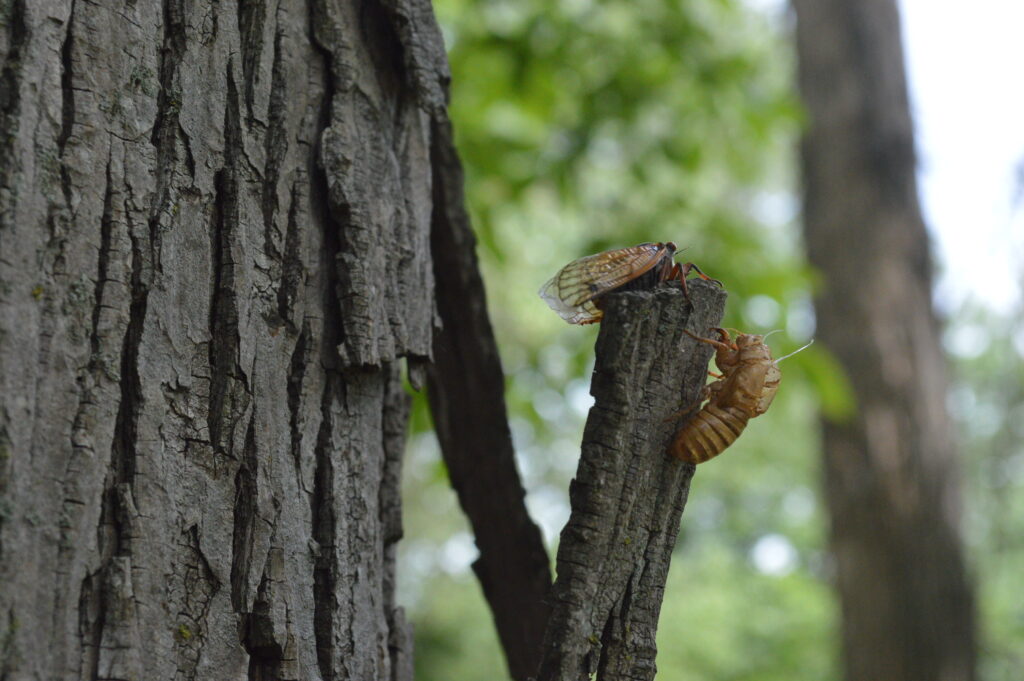
MARENGO, Iowa — Iowans accustomed to the songs of annual cicadas every summer may notice differences with the periodical cicadas making an appearance this year.
Brood XIII began emerging in east-central Iowa in late May after 17 years underground.
Read more: Nature Watch: cicada emergence
Entomologists note that in 2024, two broods — a 13-year and 17-year brood — are emerging, with some regions, including areas of Illinois, experiencing both broods at the same time; a co-emergence that has not happened for 221 years. The last occurrence was in 1803, when Thomas Jefferson was president.

Two cicadas make their way up a shagbark hickory tree in rural Marengo, Iowa. (photo/Cindy Hadish)
With their red eyes, periodical cicadas physically differ from the dark-eyed annual cicadas and are smaller in size.
And while annual cicadas sing at night, providing that quintessential sound of summer, periodical cicadas make a higher-pitched, less melodic, noise during the daytime.
Read more: Cicadas: Sounds of summer

An annual cicada, with dark eyes, emerges at night from its shell in Iowa during a previous summer. (photo/Cindy Hadish)
Their timing also differs, with periodical cicadas crawling out from underground in late May and June, versus the emergence of annual cicadas in July and August.
Both have the same objective: to mate, and neither is harmful. Most live just five or six weeks after their time underground as nymphs.
Cicada nymphs dig their way out of the soil and climb up tree trunks, posts and poles. The outer shell of the nymph splits along the middle of the back, with the winged adult laboriously emerging, leaving its shell behind.

A periodical cicada emerges from its exoskeleton on May 31, 2024, in rural Marengo. (photo/Cindy Hadish)
Read more about periodical cicadas in this article from Zach Schumm, Iowa State University Extension and Outreach Yard and Garden:
Periodical cicadas are a unique group of cicada species that emerge in unison in 13- or 17-year cycles depending on the specific brood. There are at least fifteen active broods of periodical cicadas that exist today; others have gone extinct. In 2024, two broods, a 13- and 17-year brood, will be emerging, and some regions will experience both broods at the same time. This co-emergence has not happened with these two broods for 221 years. That was in 1803, when Thomas Jefferson was president, and the first public library was opening in the U.S.!

Both periodical and annual cicadas leave behind an exoskeleton, or shell. (photo/Cindy Hadish)
In Iowa, we will mostly experience one brood, called “brood thirteen”, which are 17-year cicadas. The last time this brood of cicadas emerged was in 2007. Brood thirteen will emerge in east central Iowa, extending as far west as Tama county. This brood also emerges in parts of Illinois, and small areas of Indiana, Wisconsin, and Michigan. The other brood emerging this year is called “the great southern brood” or “brood nineteen” and is one of the largest, emerging in several states across the Midwest and southeast. In Iowa, this brood is likely to emerge in Lee and Van Buren Counties, but unlikely elsewhere.
While it is hard to precisely predict the exact locations that all the cicadas will emerge, it is highly unlikely we will see the double emergence in Iowa; the only areas that will likely see the double emergence are a selection of counties in central Illinois. In addition, most Iowans will not experience any cicadas at all.

Young periodical cicadas may look albino when first emerging, but quickly darken in appearance. (photo/Cindy Hadish)
If you do experience cicadas, they do not pose a threat to people or pets. They are likely to emerge in more forested areas, so residential areas are also unlikely to experience high numbers, but this can be variable.
Cicadas may feed on the sap of trees as adults, but this is unlikely to impact the health of trees. The adult cicadas will lay their eggs into the tips of tree branches, which may cause the tip dieback, but this will not impact the health of well established, otherwise healthy trees. However, if cicadas choose to lay eggs in small trees or new plantings, it is more likely that the tree will experience negative health impacts. If you are in the region of the cicada emergences, it may be beneficial to delay planting new trees. Overall, there is no need to be concerned about periodical cicada emergences. It’s more an opportunity to go searching for them to experience these interesting, infrequent events!
See more from the Brood XIII emergence in rural Marengo (photos © Cindy Hadish/Homegrown Iowan)












[…] Story continues […]
[…] Learn about another summertime emergence: Cicadas make a brood awakening […]